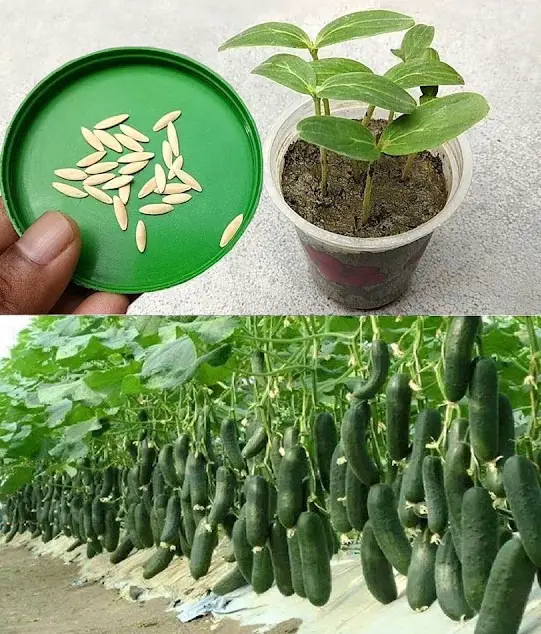Avoid These 15 Common Mistakes for a Successful Cucumber Harvest
Growing cucumbers can be a rewarding experience, offering a variety of shapes and flavors. However, ensuring a thriving cucumber harvest requires careful attention to common mistakes that can hinder their growth. In this guide, gardening enthusiast Liessa Bowen outlines 15 crucial errors to avoid, providing insights to enhance your cucumber cultivation this season.
Cucumber Gardening Overview:
Cucumbers, belonging to the annual, warm-season, vining plant category (Cucumus sativus), produce diverse and edible fruits. Beyond the familiar slicing varieties, cucumbers exhibit a range of characteristics, from green to variegated, long to short, and smooth to bumpy textures. With proper care, cucumber vines yield a bounty of fresh, crunchy fruits suitable for slicing, snacking, or pickling.
-
Improper Seed Storage:
Storing cucumber seeds correctly is vital for optimal germination. Track seed age, as they remain viable for up to five years when stored in airtight containers in a cool, dry place. Before planting, inspect seeds for firmness, smoothness, and an off-white color, discarding any that appear soft or moldy.
-
Starting Too Early:
Cucumbers thrive in warm temperatures, making early planting unnecessary. Wait until late spring or early summer, ensuring nighttime temperatures stay above 50°F and daytime temperatures reach the mid-70s. Starting seeds indoors may offer a head start for northern growers, but transplanting should only occur after hardening off the seedlings.
-
Poor Soil Quality:
Cucumbers flourish in warm, rich, fertile soil with a pH between 6.0 to 6.8. Enhance soil with organic matter, like compost, while ensuring proper drainage to avoid waterlogged conditions. Thoroughly mix compost with existing garden soil to a depth of 6 to 8 inches.
Please Head On keep on Reading (>)
-
Not Enough Sun:
Cucumbers require at least 6 hours of bright sunlight daily, favoring morning sun over the intense afternoon rays. Adequate sunlight promotes healthy growth, while excessive exposure in hot climates may lead to leaf burn and browning.
-
Not Watering Enough:
Maintain consistently moist soil conditions by watering cucumbers regularly, especially during droughts. Fruits grown with insufficient water may develop bitterness and poor texture, affecting both taste and quality.
-
Improper Watering:
Use soaker hoses or long-handled watering wands to direct water to the roots, preventing issues like stunted growth and disease. Avoid wetting the leaves excessively, as it creates a conducive environment for fungal diseases.
Please Head On keep on Reading (>)
-
Crowded Plants:
Allow sufficient space between cucumber plants, preventing overcrowding and competition for sunlight, water, and nutrients. Proper spacing accommodates sprawling vines, whether grown in raised hills or on trellises.
-
Too Many Weeds:
Maintain a weed-free garden to prevent competition for resources and minimize pest habitats. Hand-pull weeds or use small hand cultivators in smaller areas, avoiding herbicides that may harm cucumber plants.
-
No Mulch:
Utilize organic mulch like straw, shredded leaves, or compost to enrich the soil, retain moisture, and suppress weed growth. While other materials like newspapers or cardboard control weeds, prioritize mulches that also enhance soil fertility.
-
Insufficient Fertility:
Fertilize cucumber plants to ensure healthy growth and higher yields. Use nutrient-rich soil or apply organic fertilizer mid-season, following product instructions closely. Alternatively, side-dress plants with organic compost for added fertility.
Please Head On keep on Reading (>)
-
Not Using a Trellis:
Maximize cucumber growth by providing a trellis for climbing. This prevents sprawl, increases exposure to sunlight and pollinators, and keeps fruits clean and accessible for harvesting.
-
Waiting for Problems to Get Worse:
Proactively address issues like pests, diseases, or nutrient deficiencies as soon as they arise. Prompt identification and intervention are essential for preventing the escalation of problems that could compromise your cucumber crop.
-
Not Rotating Crops:
Rotate cucumber crops annually to maintain soil fertility and reduce the risk of plant-specific diseases. If rotation isn’t feasible, closely monitor soil nutrients and supplement with nutrient-rich soil to sustain healthy cucumber growth.
Please Head On keep on Reading (>)
-
Improper Harvesting:
Harvest cucumbers correctly to avoid damaging vines. Use a knife or sharp clipping tool to cut fruits just above the stem, preventing injury to the plant. Store harvested cucumbers in the refrigerator crisper drawer for optimal freshness.
-
Harvesting Too Late:
Harvest cucumbers promptly to avoid overripening, which leads to toughness and bitterness. Different cucumber varieties exhibit varied ripening times, so monitor closely and pick fruits at their peak size and color.
By steering clear of these 15 common mistakes, you can ensure a successful cucumber harvest. From proper seed storage to timely harvesting, these insights will guide you toward a thriving cucumber garden, providing a bounty of fresh and flavorful fruits throughout the season.
